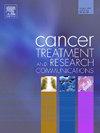摘要本研究旨在探讨台湾低her2乳癌的流行情况、临床病理特征、治疗方法及转归
IF 2.4
Q3 Medicine
引用次数: 0
摘要
人表皮生长因子受体2 (HER2)的二元分类为HER2阳性[免疫组织化学(IHC) 2+/原位杂交(ISH)+或3+]或HER2阴性(IHC 0、1+或2+/ISH-),由于抗HER2抗体-药物偶联曲妥珠单抗德鲁西替康在HER2低(IHC 1+或2+/ISH-)不可切除/转移性乳腺癌(mBC)患者中的疗效,已被重新评估。然而,对台湾低her2型mBC的患病率和预后知之甚少。方法回顾性研究2017 - 2020年诊断的HER2阴性不可切除/mBC患者的HER2 IHC玻片。研究了her2 -低患病率(her2阴性)、临床病理特征、治疗方法和her2 -低不可切除/mBC患者的预后。在恢复的her2阴性队列中,her2低患病率为61.2%(186/304),在非Ventana 4B5检测的载玻片(与Ventana 4B5相比)和转移部位的载玻片(与原发肿瘤相比)中略高。历史和恢复的IHC之间的总体百分比一致性很高(90.1%)。对于HR+/ her2低的患者,前两线治疗多采用内分泌治疗,二线治疗后多采用化疗。化疗是HR-/ her2低患者的主要治疗方法。HR+/ her2低组(N = 138)与HR-/ her2低组(N = 48)相比,一线全身治疗后的下一次治疗时间(TTNT)和总生存期(OS)更长(中位TTNT: 7.6个月vs 4.8个月;中位OS: 37.7 vs 18.8个月)。结论台湾三分之二的her2阴性不可切除/mBC患者为her2低。随着HER2分类模式的发展,重新评估HER2阴性患者的HER2状态可以改善治疗策略。本文章由计算机程序翻译,如有差异,请以英文原文为准。

A retrospective study to investigate the prevalence and describe the clinicopathological characteristics, treatments, and outcomes of HER2-low Breast Cancer in Taiwan
Background
The binary classification of human epidermal growth factor receptor 2 (HER2) as HER2-positive [immunohistochemistry (IHC) 2+/in situ hybridization (ISH)+ or 3+] or HER2-negative (IHC 0, 1+, or 2+/ISH-) has been reassessed due to the efficacy of an anti-HER2 antibody-drug conjugate—Trastuzumab Deruxtecan in HER2-low (IHC 1+ or 2+/ISH-) unresectable/metastatic breast cancer (mBC) patients. However, little is known about the prevalence and outcomes of HER2-low mBC in Taiwan.
Methods
This retrospective study rescored archived HER2 IHC slides of HER2-negative unresectable/mBC patients diagnosed from 2017 to 2020. The HER2-low prevalence (among HER2-negative), clinicopathological characteristics, treatments, and outcomes of HER2-low unresectable/mBC patients were investigated.
Results
Of the rescored HER2-negative cohort, HER2-low prevalence was 61.2 % (186/304) and slightly higher in slides tested by non-Ventana 4B5 assays (vs. Ventana 4B5) and slides from metastatic sites (vs. primary tumors). The overall percentage agreement between historical and rescored IHC was high (90.1 %). For HR+/HER2-low patients, endocrine therapies were frequently used in the first two lines of treatment, while chemotherapy was more common after the second-line treatment. Chemotherapy was the predominant treatment for HR-/HER2-low patients. Time to next treatment (TTNT) and overall survival (OS) since the first-line systemic therapy were longer in the HR+/HER2-low (N = 138) compared to HR-/HER2-low (N = 48) cohorts (median TTNT: 7.6 vs. 4.8 months; median OS: 37.7 vs. 18.8 months).
Conclusion
This study suggested that two-thirds of HER2-negative unresectable/mBC patients in Taiwan were HER2-low. Reassessing the HER2 status of HER2-negative patients could improve treatment strategies with the evolving HER2 classification paradigm.
求助全文
通过发布文献求助,成功后即可免费获取论文全文。
去求助
来源期刊

Cancer treatment and research communications
Medicine-Oncology
CiteScore
4.30
自引率
0.00%
发文量
148
审稿时长
56 days
期刊介绍:
Cancer Treatment and Research Communications is an international peer-reviewed publication dedicated to providing comprehensive basic, translational, and clinical oncology research. The journal is devoted to articles on detection, diagnosis, prevention, policy, and treatment of cancer and provides a global forum for the nurturing and development of future generations of oncology scientists. Cancer Treatment and Research Communications publishes comprehensive reviews and original studies describing various aspects of basic through clinical research of all tumor types. The journal also accepts clinical studies in oncology, with an emphasis on prospective early phase clinical trials. Specific areas of interest include basic, translational, and clinical research and mechanistic approaches; cancer biology; molecular carcinogenesis; genetics and genomics; stem cell and developmental biology; immunology; molecular and cellular oncology; systems biology; drug sensitivity and resistance; gene and antisense therapy; pathology, markers, and prognostic indicators; chemoprevention strategies; multimodality therapy; cancer policy; and integration of various approaches. Our mission is to be the premier source of relevant information through promoting excellence in research and facilitating the timely translation of that science to health care and clinical practice.
 求助内容:
求助内容: 应助结果提醒方式:
应助结果提醒方式:


